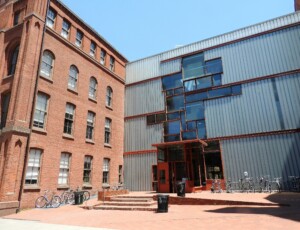Jonathan Hill taught in the Bartlett School of Architecture at University College London from mid-1989 up until his death on November 1, at the age of 65. The cause was cancer.
When Hill started work at the Bartlett, he was also finishing his part-time studies there on what was called the MSc in the History of Modern Architecture. He already taught a bit of design studio at the Architectural Association, where he had studied for his diploma, and his move up toward the northern end of Gower Street prefigured that made soon afterwards by Peter Cook.
Jonathan always described himself as an architect and an architectural historian. However, he was never a typical architectural historian as such, preferring instead to teach the subject via his highly successful postgraduate design studio—Unit 12, in Bartlett parlance. His co-tutors over the years included Ganit Mayslits, Matthew Butcher, and, for longest of all, Elizabeth Dow. Among the many notable students who spent time in that unit, Lesley Lokko went on to curate this year’s Venice Architecture Biennale. Jonathan would blossom whenever taking students around buildings on field trips, notably to Italy, introducing them also to the pleasures of negronis and chocolate covered coffee beans.
His twin interests in architectural design and architectural history soon led to Jonathan working on the proposal to set up a totally new type of doctorate at the Bartlett, the PhD by Architectural Design, along with Phil Tabor. Jonathan himself became the inaugural graduate on this programme, in 2000. This made him one of the first, if not the first, person to obtain a design-based architectural doctorate. His PhD thesis consisted of two projects: One reimagined Mies van der Rohe’s Barcelona Pavilion within the climatic conditions of Berlin, and the other was a provocative anti-RIBA that inveigled itself into the latter institution from beneath the pavements in Portland Place.
Always a proud 1980s postmodernist, Jonathan however rejected the narrow stylistic view promoted by Charles Jencks for a vision that he articulated on his own terms. He had worked for John Outram during his professional training, especially on the much-applauded Isle of Dogs Pumping Station; it was this more historically nuanced and richer idea of postmodernism that Jonathan adhered to in his scholarship. He was utterly fascinated by the concept of drawing as a means by which architects could literally draw forth a panoply of ideas; suitably, when he was made a Bartlett professor, his title was Professor of Architecture and Visual Theory.
Jonathan was the sole director of the PhD by Architectural Design programme for two decades, only passing on the baton to another of his former students, Nina Vollenbroker, when his illness first emerged. Today, it is the largest component within the Bartlett’s large PhD cohort and attracts talented students from all around the globe. Due to his work on that program, Jonathan became internationally known as one of the main promoters of architectural design research, a fusion of thinking, reading, designing, drawing, and writing that he traced back over five centuries to Leon Battista Alberti’s De Re Aedificatoria. Alongside Jane Rendell and myself, he also set up the innovative Design Research in Architecture book series.
A prolific author of his own books such as Weather Architecture (2012) and The Architecture of Ruins (2019), Jonathan’s use of prose was widely admired. He developed his own supra-elegant personal writing style that linked together his favorite topics—John Evelyn’s Fumifugium treatise on seventeenth-century London, William Kent’s gardens, the John Soane Museum, Denys Lasdun, Louis Kahn, and so on—through subtle ruminations about the ways in which architecture, landscape and history are intertwined with each other. He admitted that he struggled for a long time to come to terms with his own Englishness. In that sense, his books can be seen as an ongoing path of self-analysis. Jonathan was also an early writer on issues of environmentalism and ecology, yet he never strayed into the technical aspects that so often typify that approach; for him, it was the poetics of planetary sustainability that were of importance.
In addition to a central London flat in Primrose Hill, Jonathan also worked from a cottage in North Norfolk that overlooked the grounds of his beloved Holkham Hall, where Jonathan was happiest restoring and tending his own overgrown garden. He dreamed of building a tower where he could write while surveying the rolling landscape and see as far as the sea. In more recent years he was joined in his passion for Norfolk by his wife and soulmate, Izabela Wieczorek, a Polish architect who had taught in Madrid and Aarhus prior to her current position at the University of Reading.
Those who knew and worked with Jonathan adored him. He was universally popular because of his intelligence, his unfailing generosity to students and colleagues, and his softly probing questions, often conveyed with a puzzled expression and infectious giggle, that always made you think very hard about whether what you had just said was correct. Jonathan was a true pillar of the Bartlett School of Architecture. Now there are countless students who are now as heartbroken as his teaching colleagues that he will not be there at the next tutorial or research seminar. We will all miss him enormously.
Murray Fraser is a design tutor and architectural historian at the Bartlett School of Architecture, University College London. He previously filed an obituary for Hill in The Guardian.










